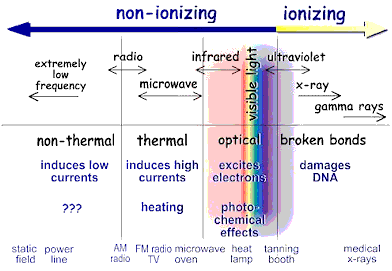|

Non-ionizing
radiation refers to any type of electromagnetic radiation that does not
carry enough energy to completely remove an electron from an atom or
molecule. Non-ionizing
radiation is described as a series of energy waves composed of oscillating
electric and magnetic (or electromagnetic) fields (EMF) traveling at the speed of light.
Non-ionizing
radiation can be characterized by a wavelength and a frequency. The
wavelength is the distance covered by one complete cycle of the
electromagnetic wave, while the frequency is the number of electromagnetic
waves passing a given point in one second.
The light from
the sun that reaches the earth is largely composed of non-ionizing
radiation. Visible light is a form of non-ionizing radiation that we can
see. Visible light has wavelengths in the range of 400 to 700
nanometers. It stretches from the color red on the longest wavelength to the
color violet on the shortest wavelength of visible light. About 49% of
the energy that reaches the earth from the sun is in the form of visible
light.
Other types of non-ionizing radiation are:
Occupational
Safety and Health Agency (OSHA) on Non-Ionizing Radiation
Food and Drug Administration (FDA) examples of Radiation Emitting Devices
|